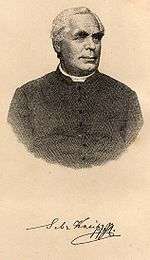Bad Wörishofen
| Bad Wörishofen | ||
|---|---|---|
 Kurhaus of Bad Wörishofen | ||
| ||
 Bad Wörishofen Location of Bad Wörishofen within Unterallgäu district  | ||
| Coordinates: 48°00′21″N 10°35′49″E / 48.00583°N 10.59694°ECoordinates: 48°00′21″N 10°35′49″E / 48.00583°N 10.59694°E | ||
| Country | Germany | |
| State | Bavaria | |
| Admin. region | Schwaben | |
| District | Unterallgäu | |
| Government | ||
| • Mayor | Klaus Holetschek (CSU) | |
| Area | ||
| • Total | 57.80 km2 (22.32 sq mi) | |
| Elevation | 603-670 m (−1,595 ft) | |
| Population (2017-12-31)[1] | ||
| • Total | 15,922 | |
| • Density | 280/km2 (710/sq mi) | |
| Time zone | CET/CEST (UTC+1/+2) | |
| Postal codes | 86825 | |
| Dialling codes | 08247 | |
| Vehicle registration | MN | |
| Website | www.bad-woerishofen.de | |
Bad Wörishofen (German pronunciation: [ˈvøːʁɪsˌhoːfə̆n]) is a spa town in the district Unterallgäu, Bavaria, Germany, known for the water-cure (hydrotherapy) developed by Sebastian Kneipp (1821–1897), a Catholic priest, who lived there for 42 years. Many of the resort hotels and boarding-houses in Bad Wörishofen offer their guests treatment using Kneipp's methods.
The new spa complex out of town is called Therme Bad Wörishofen. Time Magazine called the city "The secret capital of health".[2]
Geography
The town is located on the Wörthbach, a tributary of the Mindel River, in Donau-Iller which is a frontier region straddling Bavaria and Baden-Württemberg. It is approximately 80 km / 50 miles west of Munich and 35 km / 22 miles east of Memmingen.
History
The first known reference to the place dates from 1067, where it is described as the lordship "Werenshova". The name is thought to mean "Homestead of Werin". For centuries Wörishofen was an agricultural settlement. Between 1719 and 1721 the Dominican Wörishofen Monastery was built under the direction of Dominikus Zimmermann.
After World War II, with south-western Germany belonging to the American occupation zone, Bad Wörishofen was the site of a displaced persons camp.[3] Most of the displaced people in question were of Lithuanian provenance. The camp enjoyed the confidence and support of the UNRRA, and was accordingly permitted to print its own bank notes.
Celebrity connections
Film director Rainer Werner Fassbinder and actor Yank Azman were born in Bad Wörishofen.
Personality
Sons and daughters of the town
- Rainer Werner Fassbinder (1945–1982), film director
- Jeremias Schröder OSB (born 1964 as Maximilian Schröder), Benedictine Abbot President of the Benedictine Congregation of St. Ottilie
Personalities associated with Bad Wörishofen
- Hermann Aust (1853–1944), supporter of Sebastian Kneipp and supporter of the development of the spa town Bad Wörishofen
- Viktor Frankl (1905–1997), founder of the logotherapy, worked in 1945 in Bad Wörishofen as a doctor in the 'Hospital for Displaced Persons

- Sebastian Kneipp (1821–1897), pastor and Hydrotherapeut, inventor of the Kneipp cure
- Katherine Mansfield (1888–1923), English/New Zealand writer, wrote the short stories in In a German Pension after a stay in 1909
- Franz "Bulle" Roth (born 1946), football player for German national football team and FC Bayern München, owner of a shop for sportswear in Bad Wörishofen
- Ulla Salzgeber (born 1958), dressage rider, lived till 2011 in Bad Wörishofen
- Irmgard Seefried (1919–1988), soprano, lived from 1923 to 1940 in Bad Wörishofen, winner of the Public Service Medal in Gold of the city Bad Wörishofen
- Ethel Smyth (1858–1944), English composer, was resident some time in Munich, took the cure here in 1889
Economy
Wörishofer sandals are made here.[4]
Notes and references
- ↑ "Fortschreibung des Bevölkerungsstandes". Bayerisches Landesamt für Statistik und Datenverarbeitung (in German). September 2018.
- ↑
- ↑ DP Camp Bad Wörishofen
- ↑ Imogen Fox (23 July 2010), "Ooh, but they are comfy . . .", The Guardian: 13
| Wikimedia Commons has media related to Bad Wörishofen. |
